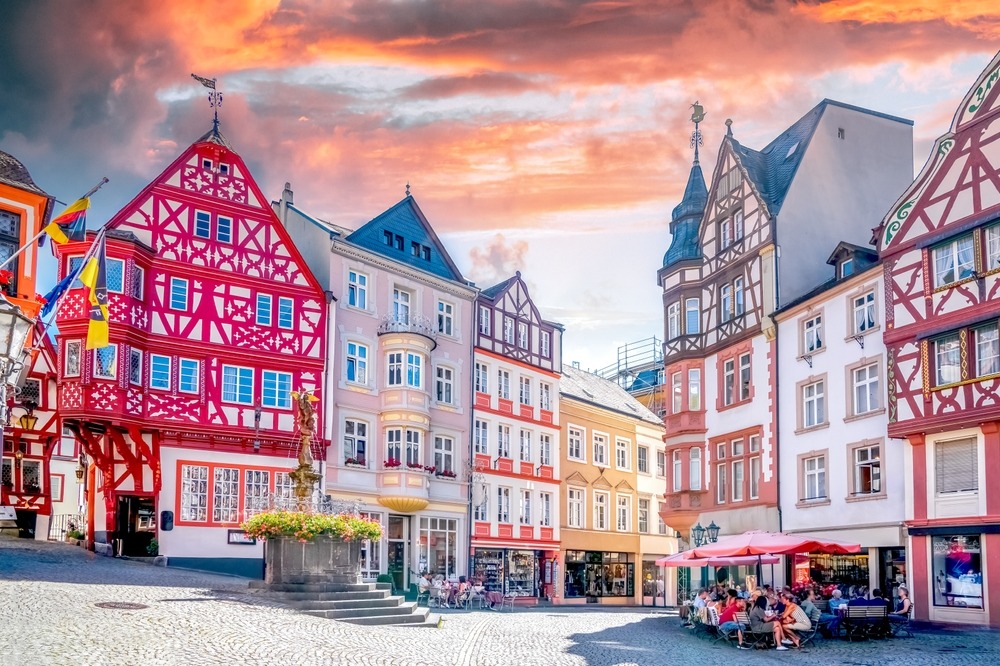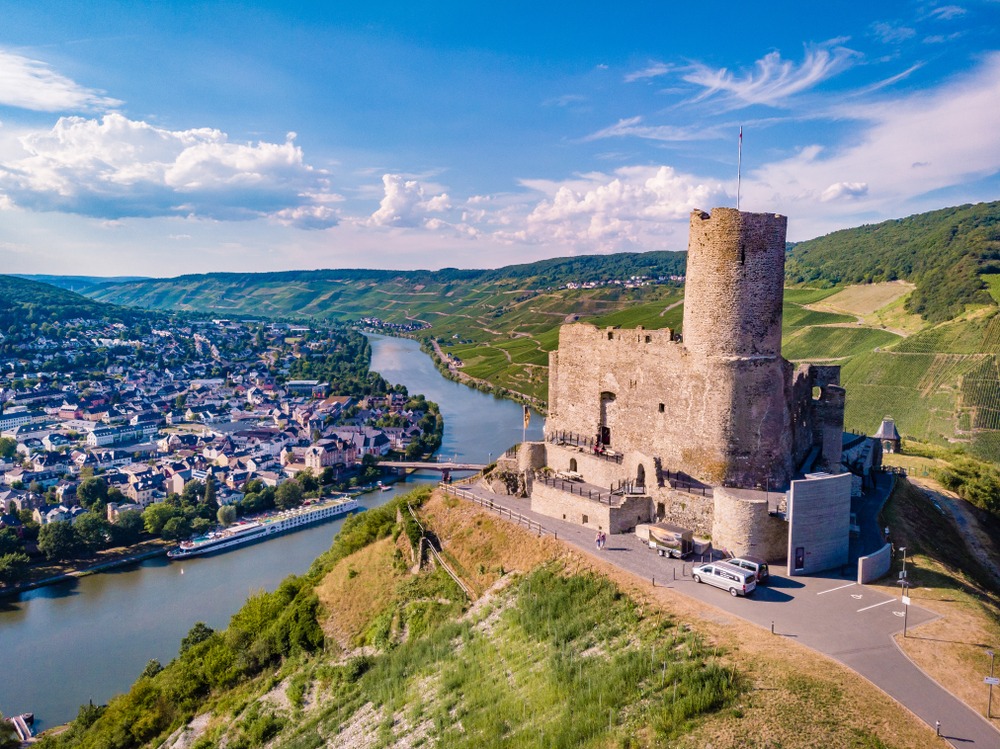The History and Top 25 Attractions of Bernkastel-Kues, Germany
History of Bernkastel-Kues
Situated along the scenic middle stretch of the Moselle River in the Rhineland-Palatinate region of western Germany, Bernkastel-Kues is a town rich in medieval charm, winemaking heritage, and cultural depth. It consists of two historically distinct towns—Bernkastel on the right bank and Kues on the left—which merged in 1905 to form a single municipality. Together, they tell a story that spans Roman antiquity, ecclesiastical power, and centuries of prosperity tied to the river and the vine.
The area’s history dates back to Roman times, when the Moselle Valley was settled due to its fertile soil and strategic river location. Archaeological findings suggest that a Roman road passed through the region and that viticulture was already practiced here over 2,000 years ago. The Romans recognized the region’s potential for grape cultivation and laid the groundwork for what would become one of Germany’s most respected wine-growing regions.
The name “Bernkastel” is first documented in the 11th century, while “Kues” appears slightly earlier, known for its agricultural and trade significance. The most notable figure from the region is undoubtedly Nikolaus von Kues (Latin: Cusanus), a 15th-century philosopher, theologian, mathematician, and cardinal born in Kues in 1401. He was a major figure in the Renaissance and an early proponent of learned humanism. Cusanus bequeathed much of his wealth to establish the St. Nikolaus Hospital in Kues, which still stands today as both a retirement home and cultural landmark.
During the Middle Ages, Bernkastel flourished under the Electorate of Trier. In 1291, King Rudolf I granted Bernkastel its town rights, leading to an era of fortification and economic growth. The town was known for its market rights, timber-framed houses, and strong fortifications. The castle, Burg Landshut, was built above the town around this time to protect the area and exert authority over the Moselle Valley. Though destroyed by fire in the 17th century, its ruins still tower above the town today.
Like many Moselle towns, Bernkastel-Kues endured conflicts during the Thirty Years’ War, the French Revolution, and both World Wars. Nevertheless, it retained much of its historical architecture and traditional character. Today, it is celebrated for its stunning medieval old town, scenic riverfront, and globally acclaimed Riesling wines.

Top 25 Attractions in Bernkastel-Kues
-
Burg Landshut – The ruins of this hilltop castle offer sweeping views of the Moselle Valley and are steeped in centuries of regional history.
-
Medieval Market Square (Marktplatz) – One of the most picturesque squares in Germany, surrounded by ornate half-timbered buildings and the Renaissance-style Town Hall.
-
Cusanus Birthplace (Cusanus-Geburtshaus) – A modest yet significant house museum celebrating the life and works of Nikolaus von Kues.
-
St. Nikolaus-Hospital (Cusanusstift) – A 15th-century charitable institution founded by Cusanus, with a stunning Gothic chapel and an extraordinary medieval library.
-
Mittelalterlicher Spitzhäuschen – The “Pointed House,” built in 1416, is one of the oldest and most photogenic timber-framed buildings in the region.
-
Mosel Wine Museum (Mosel Weinmuseum) – Explore the history of winemaking in the Moselle region through interactive exhibits and a vast wine collection.
-
Weinkulturelles Zentrum – This cultural center combines historical wine knowledge with modern tastings, often hosting educational wine events.
-
Doctor Weinstube and Doctor Vineyard – This famous local vineyard is tied to the legendary Bernkasteler Doctor wine, with tours and tastings available.
-
Mosel River Promenade – A peaceful place to stroll, offering views of the river, vineyards, and hills, with cafés and benches along the path.
-
Bernkastel-Kues Old Town – Wander through narrow alleys filled with centuries-old buildings, wine taverns, boutique shops, and flower-lined balconies.
-
Graacher Tor – The preserved city gate from the 14th century that once served as an entrance to the fortified town.
-
Mosel Cycle Route – A cycling trail that passes through the town, ideal for seeing the Moselle landscape and nearby wine villages.
-
Panorama Trail (Panoramaweg) – This scenic walking trail takes you through the vineyards with incredible views of the valley below.
-
Catholic Parish Church of St. Michael – Located in Bernkastel, this late-Gothic church features a Baroque organ and striking stained glass windows.
-
Wine Cellars and Tasting Rooms – Numerous local wineries offer cellar tours and tastings, such as Weingut Dr. Loosen, Weingut Thanisch, and Weingut S.A. Prüm.
-
St. Briktius Church in Kues – A Romanesque-Gothic parish church with significant historical and architectural features.
-
Mosel-Vinothek & Wine Tasting Center – A cooperative of local wine producers offering over 150 wines for sampling in a vaulted cellar setting.
-
Bernkasteler Advent Market – A charming Christmas market held each December, featuring regional crafts, mulled wine, and festive ambiance.
-
Boat Tours on the Moselle – River cruises departing from Bernkastel-Kues give visitors a unique perspective on the vineyards and riverside towns.
-
Ring of Vineyards Hike (Rundwanderweg) – A well-marked hiking trail encircling the town, passing through steep vineyards and historic terraces.
-
Kues Sculpture Trail (Skulpturenweg) – A modern art walk featuring outdoor sculptures that complement the town’s historic backdrop.
-
Heimatmuseum Graacher Tor – A small local museum inside the old city gate, showcasing life in Bernkastel through the centuries.
-
Wittlich Gate and Tower Remnants – Part of the town’s original fortifications, offering insight into Bernkastel’s medieval defenses.
-
Vineyard Railway Tour (Rebenbummler) – A small land train that winds through the local vineyards, offering guided commentary and panoramic views.
-
Annual Weinfest der Mittelmosel – Held in late summer, this is one of the most celebrated wine festivals along the Moselle, complete with parades, tastings, music, and fireworks.

Bernkastel-Kues blends historical reverence with the pleasures of modern-day winemaking and hospitality. Whether sipping Riesling in a centuries-old wine tavern or exploring the scholarly legacy of Nikolaus von Kues, visitors discover a town that embodies the romance, resilience, and richness of the Moselle Valley.

































